
The history of the National University 'Odesa Law Academy' dates back long before the fateful decision to establish Odesa Law Academy. Specifically, almost two hundred years before Ukraine gained statehood and independence. During this time, the fundamental concepts, principles, and traditions that today's students and staff of the National University 'Odesa Law Academy' uphold and develop were formed.
The National University 'Odesa Law Academy' is the successor to the rich traditions of Odesa School of Law. It is worth noting that a scientific school is a type of scientific community and a special form of cooperation in scientific activities. The development of many branches of science is directly linked to the activities of scientific schools. Thus, the history of the Law Academy begins with the emergence and development of Odesa School of Law, dating back to 1817.
At the beginning of the 19th century, in the context of the specialization of educational institutions in Ukraine, a new system for training legal professionals began to take shape. Institutions providing universal legal education, such as law faculties of universities and departmental institutions, started their work. Additionally, specialized legal lyceums were established, concentrating competent legal scholars and practitioners within a single region, thereby forming distinct schools of law.
Odesa became a center for the development of legal, educational, administrative, and economic spheres in Ukraine. The Richelieu Lyceum was chosen as the institution that would bring together the brightest minds of the region and facilitate necessary communication between science and industry. This secondary educational institution was founded on May 2, 1817, based on Odesa Noble Institute. The lyceum was named after Duke de Richelieu, who, with the support of Minister of Public Education Count O. K. Rozumovsky (a descendant of the former Ukrainian Hetman Kyrylo Rozumovsky), actively contributed to the advancement of education in Ukraine.

Catherine Square in Odesa. Lithograph of the 19th century.

The building of the Richelieu Lyceum (1817–1857).
In 1817, the Richelieu Lyceum included a pedagogical institute with 24 students who, upon completing their studies, remained at the lyceum as tutors, adjuncts, and mentors, along with an elementary and two secondary schools. The first intake of students in 1818 comprised 110 boarders and 107 full-time students.
Effectively combining the European educational system with national academic traditions, the Richelieu Lyceum quickly became one of the best secondary educational institutions in Ukraine. By the early 1830s, the lyceum had begun to specialize, opening new schools and specialized institutes for its students.
Preparatory education (study of religious law, grammar, history, geography, and arithmetic) – ages 8 to 10. Literary education: Grammar class – ages 10 to 12; Literature class – ages 12 to 14; Rhetoric class – ages 14 to 16. Higher sciences (study of mathematics, physics, mechanics, logic, metaphysics, natural and civil law, fortification, and artillery) – ages 16 to 18.
Additionally, the lyceum housed a pedagogical institute and two specialized schools that offered courses in law, political economy, commercial sciences, and accounting.
Thus, the Richelieu Lyceum provided both comprehensive and specialized education for its students. Beginning their studies at an early age with general sciences and languages, graduates had the opportunity to deepen their knowledge at higher institutes and academies that operated within the lyceum's framework.

The building of the Richelieu Lyceum in 1857–1865.
Such a well-structured system of specialities, high educational and disciplinary standards, and the best available infrastructure contributed to the rapid development of the young Richelieu Lyceum. Consequently, on July 30, 1830, when a decree was issued establishing Odesa Educational District, the Richelieu Lyceum was logically chosen as its central institution. Initially, the lyceum oversaw only educational institutions in Odesa, but by the fall of that year, the district expanded to include Bessarabia, Kherson, Tavria, and Katerynoslav provinces.
As the Richelieu Lyceum gained greater authority and status, a new Charter was adopted on May 29, 1837 (coming into force on January 1, 1838), significantly transforming the institution. It became an independent educational establishment, structurally and administratively resembling a university. The lyceum introduced separate departments in physics, mathematics, and law.
The governing bodies of the lyceum consisted of a council and an administration board, headed by the director. The number of students in both the lyceum and the gymnasium significantly increased at that time. A decision was made to expand the lyceum's territory, which was soon carried out. The law department of the lyceum offered courses in the following disciplines, namely, Latin, Roman law, the encyclopedia and history of jurisprudence, Russian legislation, and practical judicial proceedings. Additionally, the lyceum housed an Institute of Eastern Languages, which trained translators for military institutions.
On February 25, 1839, the Rules of Teaching at the Lyceum were approved, defining the form and content of lecture courses. According to memoirs of the lyceum students, during lectures, attendees maintained journals, which were read at the beginning of each subsequent lecture. These journals were later compiled into so-called notes – comprehensive lecture summaries that students only needed to memorize in order to successfully pass exams.

Title page of the 'Rules for Students of the Richelieu Lyceum' from 1840.

October 29, 1848. Approved project of the facades of the Richelieu Lyceum with the gymnasium and Noble Pension.
At the same time, in the 1860s, various branches of law – state, criminal, civil, procedural, and others – experienced rapid development. This, in turn, necessitated changes in politics, the economy, and business relations. Amid the implementation of bourgeois-democratic reforms in the state, the development of legal education in regional universities faced the challenge of training legal professionals capable of operating in accordance with the demands of the new era. Thus, the task of legal education became to provide society with a significant reservoir of scientific knowledge. Additionally, the rapidly expanding system of legal disciplines – shaped by the dynamic development of capitalism – required a strong theoretical and methodological foundation.
That is why, in 1865, a decision was made to transform the Richelieu Lyceum into the Imperial Novorossiysk University, with the establishment of a new type of law faculty. This event marked the next stage in the development of Odesa School of Law and the National University 'Odesa Law Academy'.
The Faculty of Law at the university included the following departments: 1) History of significant ancient and modern legislations; 2) History of Slavic legislations; 3) Roman law; 4) State law; 5) Police law; 6) International law; 7) Church law (canon law).
Additionally, a large cafeteria was established for students in the city center, located at 36 Khersonska Street (now Pastera Street). Interestingly, in the annex of this building, the renowned scientist Ilya Ilyich Mechnikov lived between 1867 and 1886. The university also established a student chapel, expanded dormitories, and enlarged its library.
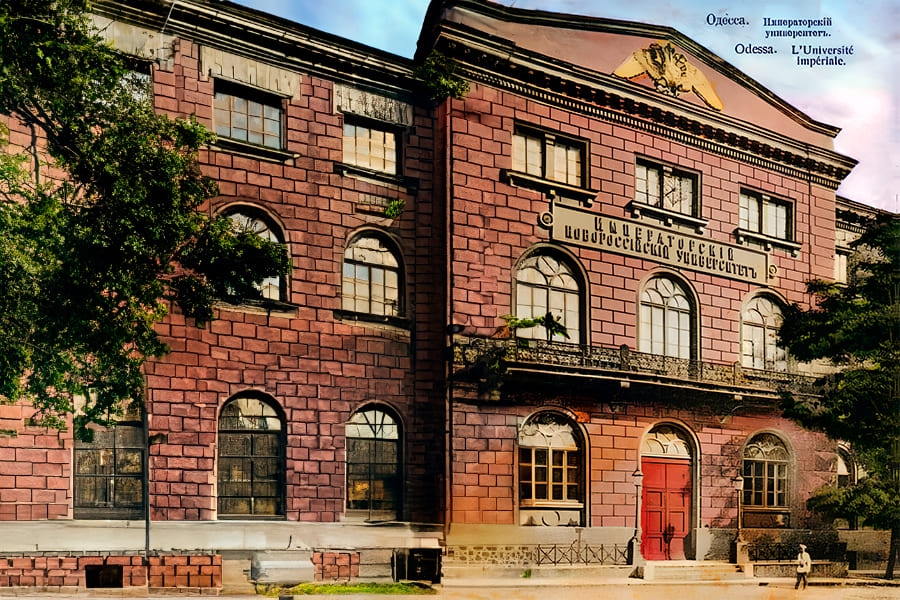
Imperial University. Photo from the late 19th century. The author is unknown.

Rectors of the Imperial University from 1865 to 1903.
In 1864, the idea of establishing a Legal Society emerged within the Faculty of Law, and it was officially founded in 1879. Its founding members included professors O. M. Bohdanovskyi, M. L. Duvernois, F. I. Leontovych, M. I. Malinin, M. I. Patlaievskyi, A. S. Posnikov, M. M. Shpylevskyi, P. P. Tsytovych, and others. During the society meetings, various pressing issues were discussed, including the implementation of bourgeois-democratic reforms. In practice, the legal society, established within the university, brought together part of the law faculty professors and representatives of the judicial institutions of Odesa Court Chamber.
The following decades of the university development were marked by the active advancement of previously established principles and standards in educational and scientific activities at the university. However, the learning process was negatively impacted by the meticulous scrutiny of educational materials by academic administrators, which led to the exclusion of crucial information on contemporary political and legal movements from political economy and state studies courses. The university autonomy in addressing internal matters and shaping curricula gradually diminished. Nevertheless, these changes did not significantly affect the quality of education received by the students or the university overall status.

The first photo – the equivalent of a modern student ID for students of the National University of Odesa. The second photo – a photograph from the personal file of a student of the National University of Odesa.

Photograph of the staff of the Imperial University on the 25th anniversary of the university.
A distinctive feature of the student body at the Faculty of Law was its leading position (sometimes alongside medical faculties) in terms of enrollment numbers, as well as the continuous growth in the number of students throughout most of the 19th century and the first quarter of the 20th century. At the beginning of the 20th century, student research achieved significant success, reflected in the high theoretical level of written works and the systematic organization of student legal research societies.
In 1920, due to state-political changes in Ukraine, the Imperial Novorossiysk University was dissolved. Over the following years, various educational institutions were established based on the university, but none lasted for an extended period. The physics-mathematics and humanities-social institutes, founded on the university's bases, were reorganized and incorporated into Odesa Institute of Public Education. In January 1933, government authorities discussed the restoration of a humanities university in Odesa. However, this process was forcibly halted due to the outbreak of World War II.

Institute of Public Education in Odesa, 1921.
In July 1941, the faculty and student body were evacuated – first to Berdyansk, then to Krasnodar, followed by Maykop and Bayram-Ali. The university resumed its work only on April 21, 1944, as part of Odesa State University. In 1945, the university was named after the world-renowned scientist and Nobel laureate I. I. Mechnikov.
The restored university united the scientific and pedagogical staff and students from most of Odesa's higher educational institutions. By the late 1980s, the university comprised nine faculties: physics, mechanics and mathematics, chemistry, biology, geology and geography, history, law, philology, and Romance-Germanic philology. New university buildings were constructed, student enrollment increased, structural changes took place, and the number of departments and specializations grew. The university's achievements in science and education solidified Odesa State University named after I. I. Mechnikov as one of the leading institutions of higher education in the Ukrainian SSR.
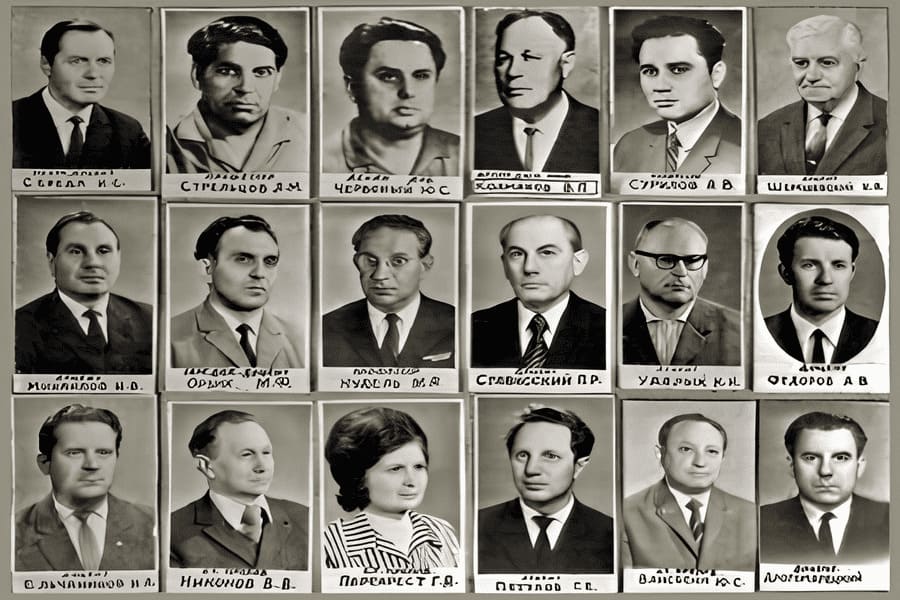
The staff of the Law Faculty of Odesa State University named after I. I. Mechnikov (1970s) (photo from the personal archive of Prof. B. A. Perezhnyak).
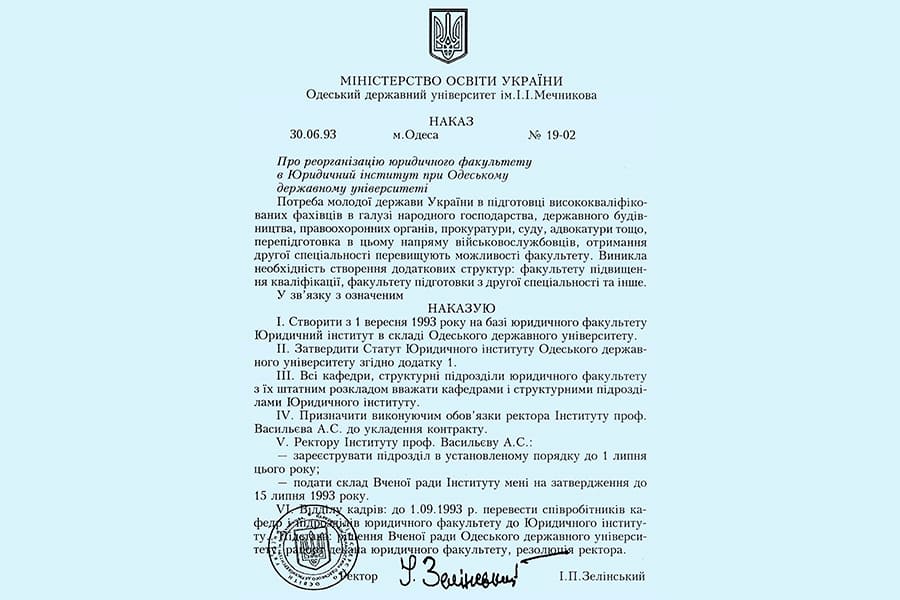
The proclamation of Ukraine as an independent democratic state in 1991 gave a new impetus to legal education. Due to the reform of the legal system and the strengthening of democratic principles, a crucial role was assigned to the training of legal professionals capable of operating in the new environment. There arose a need to establish new educational structures that would incorporate both traditional academic units and specialized institutions for professional development, postgraduate education, and preparatory training.
To address this need, on July 30, 1993, by order No. 19-02 of the rector of Odesa State University named after I. I. Mechnikov, the Faculty of Law was transformed into the Law Institute. Registered by the decision of the Executive Committee of Odesa City Council of People's Deputies No. 592 on July 1, 1993, the Law Institute of Odesa State University not only inherited the best traditions of the faculty, but also created opportunities for introducing specialized legal fields tailored to the interests of professionals across various legal disciplines.
In accordance with its Charter, the Law Institute of Odesa State University named after I. I. Mechnikov became an autonomous educational, scientific, and cultural institution. It integrated faculties, departments, research laboratories, and support services dedicated to the training, retraining, and professional development in state governance and legal studies. The establishment of the institute was preceded by extensive organizational and preparatory work.
A significant shift occurred in the approach to legal education, redefining its content and
social orientation. The key directions of legal education reform included:
• Prioritizing universal human values, needs, interests, and human rights in legal
education.
• Developing legal thinking and political and legal beliefs based on the recognition of
international law as a priority and respect for the rights of every nation.
• Emphasizing the study of 'legal practice' over the mechanical memorization of legal norms.
• Implementing specialized legal education tailored to the real needs of legal practice,
strengthening the connection between legal science and various fields of humanities, natural
sciences, and technical disciplines.
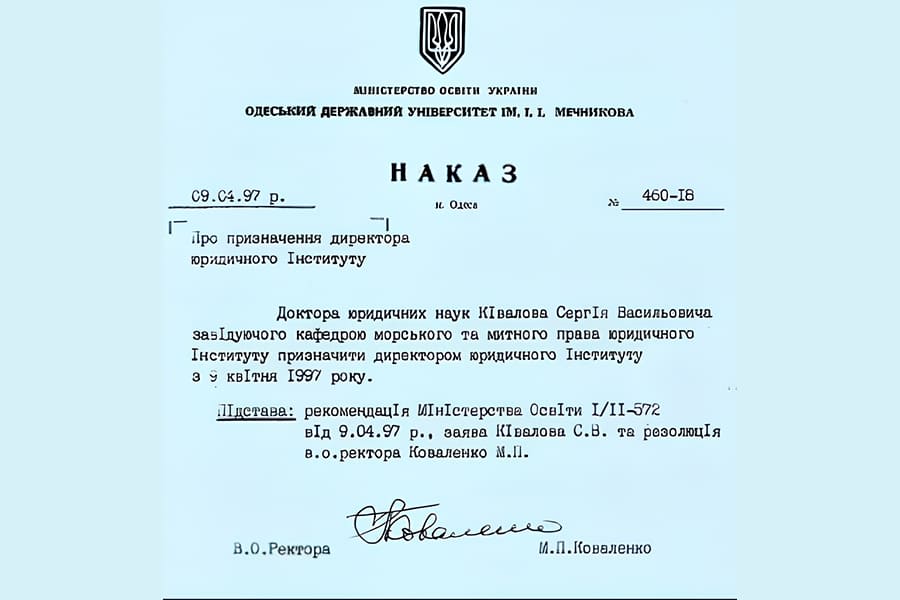
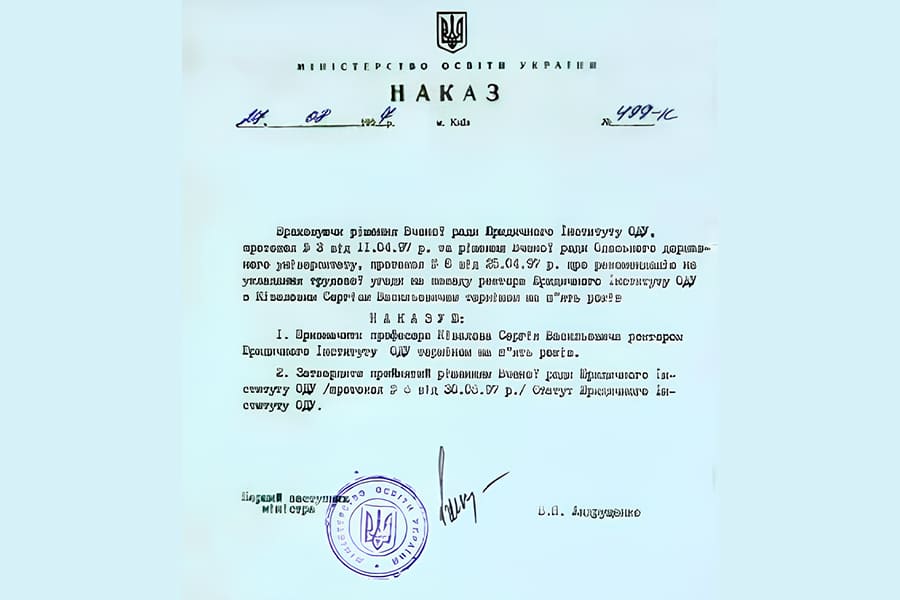
The specialization of students also underwent changes. To comprehensively address all issues related to training specialists with broad expertise, three faculties were added to the institute's structure at the initiative of the Law Institute, namely, Faculty of State Building and Governance (Dean: Associate Professor B. A. Perezhnyak); Faculty of Justice and Legal Work in the National Economy (Dean: Professor O. O. Pogribny); Prosecutorial and Investigative Faculty (Dean: Associate Professor N. A. Miroshnychenko; from September 1994 – Associate Professor Yu. Ye. Polyanskyi).
Based on the decision of the Academic Council of the Law Institute of Odesa State University (Protocol No. 3, April 11, 1997) and the decision of the Academic Council of Odesa State University named after I. I. Mechnikov (Protocol No. 8, April 25, 1997), a recommendation was made for the appointment of Sergiy Vasylovych Kivalov as Rector of the Law Institute of Odesa State University for a term of five years. By order of the Ministry of Education of Ukraine (Order No. 499-k, August 27, 1997), Professor Sergiy Vasylovych Kivalov was officially appointed Rector of the Law Institute of Odesa State University. Additionally, the institute's Statute, approved by the Academic Council of the Law Institute (Protocol No. 6, June 30, 1997), was ratified.